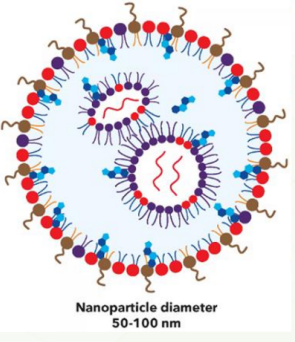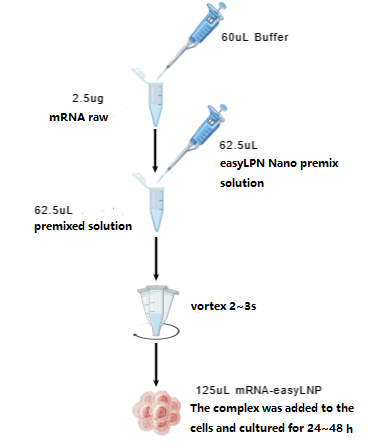- Cart 0
- English
LNP delivers mRNA, transfection So easy!
August 19, 2025
Clicks:131
Background Introduction
Bare RNA is a negatively charged hydrophilic macromolecule. Because of the electrostatic repulsion of the cell membrane, it is difficult to enter the cell, and it is easily degraded quickly by the ubiquitous RNase, so it needs a protective shell to enter the cell. The composition of the cell membrane is mainly lipids, and lipid vesicles are used to encapsulate RNA across the cell membrane and release RNA into the cytoplasm. The vesicle should be a positively charged lipid to bind to negatively charged RNA.
However, vesicles composed of permanent cationic lipids can cause cytotoxicity due to electrostatic interaction with negatively charged cell membranes, and lipid structures can be positively charged molecules in response to the acidic environment of endosomes.
Lipid nanoparticle structure
LNPs typically consist of four key components: ionizable cationic lipids, phospholipids (zwitterionic lipids) (PL), cholesterol, and PEGylated lipids.
 |
|
Ionizable Cationic Lipids (40-60%) |
|
|
Phospholipids (8-12%) |
|
|
|
Sterol Lipids (30-50%) |
|
|
|
PEGylated Lipids (1-2%) |
|
|
|
Carrier • Ionizable cationic lipids can efficiently encapsulate negatively charged oligonucleotides (e.g., siRNA, mRNA, plasmids). |
Lipid nanoparticle delivery mechanism
Lipid nanoparticles (LNPs) act as delivery systems for mRNA, and their mechanism of action involves multiple steps, ensuring safe and efficient delivery of mRNA to target cells and protein expression. In LNPs, ionizable cationic lipid plays an important role because it can be positively charged below its Ka to mediate loading of negatively charged RNA during self-assembly into LNPs, uncharged at neutral pH to minimize toxicity, and positively charged again after cellular uptake to facilitate endosomal escape as endosomal pH decreases. Variants of cholesterol and PEG lipids have been shown to modulate LNP physical properties, nanostructure, and ultimate efficacy. Zwitterionic phospholipids are often referred to as "helper lipids". LNPs play a key role in protecting mRNA, promoting intracellular transmission, and activating immune responses.
LNP Transfection Experimental Steps
6-well plate single-well reference conditions are used in the transfection steps described below. For other culture forms, please refer to Table 1.
1. Preparation of mRNA premix
2.5 ug mRNA (concentration of 1 ug/uL) was mixed with 60 uL Buffer.
2. mRNA-easyLNP complex
Mix 62.5 uL of mRNA premix with 62.5 uL of easyLNP nanosuspension, vortex for 2-3s, and mix well.
3. Add cells
125 uL of the mRNA-easyLNP complex was added to the cells and gently shaken to disperse uniformly.
4. Analysis time
Analysis after 24-48 hours of culture.
Table 1 mRNA transfection fingers according to cell culture vessel used per well
|
mRNA cell transfection step |
Reagent |
96-well plate |
24-well plate |
6-well plate |
|
(1) Preparation of 40ng/μL mRNA premix |
Buffer (taking mRNA stock solution concentration of 1 μg/μL as an example) |
2.4 μL |
12 μL |
60 μL |
|
mRNA |
0.1 μg |
0.5 μg |
2.5 μg |
|
|
(2) Preparation of mRNA-easyLNP complex |
easyLNP nanosuspension |
2.5 μL |
12.5 μL |
62.5 μL |
|
mRNA premix |
2.5 μL |
12.5 μL |
62.5 μL |
|
|
(3) Adding cells |
mRNA-easyLNP complex |
5 μL |
25 μL |
125 μL |
Experimental schematic diagram:

Product Recommendations:
|
Transfection mode |
Item number |
Product name |
Specifications |
|
Cells |
abs60339 |
mRNA Transfection Reagent |
1mL |
|
abs60620 |
easyLNP ™ mRNA immune cell transfection kit |
1.5 mL/3mL/5mL |
|
|
abs60621 |
easyLNP ™ Plus universal RNA cell transfection kit |
1.5 mL/3mL/5mL |
|
|
abs60322 |
Lipofect5000 plasmid transfection reagent |
0.5 mL/1. 0 mL |
|
|
abs60255 |
Plasmid DNA Transfection Kit (Adherent Cell) |
0.5 mL/1. 0mL/1. 5mL |
|
|
abs60256 |
PM Primary Cell Plasmid DNA Transfection Kit |
0.1 mL/0. 5mL/1. 0mL/1. 5mL |
|
|
abs60327 |
SP suspension cell plasmid DNA transfection kit |
0.1 mL/0. 5mL/1. 0mL/1. 5mL |
|
|
abs60369 |
RF 293 Cell DNA Transfection Kit |
0.5 mL/1. 5 mL |
|
|
abs60259 |
Nucleic acid transfection kit |
0.5 mL/1. 0mL/1. 5mL |
|
|
abs60324 |
PM Primary Cell Nucleic Acid Transfection Kit |
0.5 mL/1. 0mL/1. 5mL |
|
|
abs60325 |
SP suspension cell nucleic acid transfection kit |
0.5 mL/1. 0mL/1. 5mL |
|
|
abs60252 |
Small nucleic acid transfection reagent |
0.5 mL/1. 0mL/1. 5mL |
|
|
abs60253 |
PM primary cell small nucleic acid transfection reagent |
0.1 mL/0. 5mL/1. 0mL/1. 5mL |
|
|
abs60254 |
SP suspension cell small nucleic acid transfection reagent |
0.1 mL/0. 5mL/1. 0mL/1. 5mL |
|
|
abs60317 |
Nucleic acid co-transfection reagent |
0.5 mL/1. 0mL/1. 5mL |
|
|
abs7993 |
50nm magnetic transfection reagent |
100uL |
|
|
Transfection Enhancer |
abs42025397 |
Polybrene solution |
1mL |
|
abs42085824 |
Hemelonium bromide |
5g |
|
|
abs42085198 |
Protamine sulfate |
5g/25g |
|
|
In animal body |
abs60622 |
easyLNP ™ mRNA in vivo transfection kit (systemic action) |
0.3 mL/0. 5mL/1mL |
|
abs60623 |
easyLNP ™ mRNA in vivo transfection kit (local action) |
0.3 mL/0. 5mL/1mL |
|
|
Nucleic acid transfection (in animals) |
abs60258 |
Elite Fect-1 small nucleic acid biopsy transfection reagent (mouse transfection) |
3/6 |
Absin provides antibodies, proteins, ELISA kits, cell culture, detection kits, and other research reagents. If you have any product needs, please contact us.
|
Absin Bioscience Inc. Email: worldwide@absin.cn |
 Follow us on Facebook: Absin Bio Follow us on Facebook: Absin Bio |





